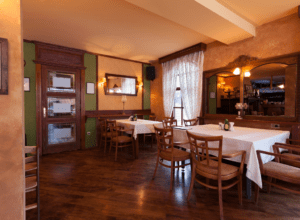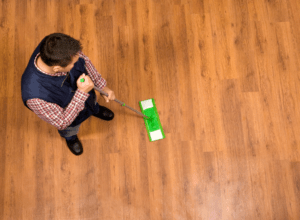

25 Sep How to Clean Vinyl Flooring
Dirty floors along hallways are always a turn-off. If you own a facility (or home) that has installed vinyl floors, the following article can explain to you how to best keep your flooring clean. With clean floors, your facility will get much more attractive to customers and comfortable for employees. Perhaps you are a home owner with vinyl plank flooring? This article will help you as well!
What is a Vinyl Floor?
Vinyl flooring is a softer flooring material that is made out of completely synthetic materials. This can include layers of fibreglass, PVC Vinyl, and a plasticiser along with a thick core. They come with a set of features that natural timber cannot reproduce, and are popular amongst both residential and commercial settings.
The characteristics of Vinyl Floors include:
- Soft & Malleable
- Designable
- 100% waterproof
- Tough and durable
- Prone to discolouration by the sun.
- Affordable
This list of qualities contributes to the reason why they are used mostly in indoor public areas. This is because they don’t mimic the feeling of real wood and may sometimes give a cheap outlook for visitors to a household. With this being said, vinyl flooring can endure high foot traffic, rolling prams and wheelchairs, and heavyweight from decorations and public furniture, on top of any moisture you throw at it.


Step 0: Preventative Measures for Vinyl Floors
Before we even begin cleaning, it is much more manageable to prevent issues before they begin. Maintaining good practise with vinyl floors will ensure that there is less cleaning or repairing to do in the future.
Furniture Pads
Like mats and runners, furniture pads protect the floor from the abrasive edges and corners of furniture. These are usually sold with an adhesive stuck on a piece of foam. When you peel off the paper on the other side of the foam, you can easily stick it onto the bottom of any chair, sofa, or table leg. Doing this makes the bottom of furniture soft on the surface of any flooring. This relieves pressure from the vinyl flooring to avoid permanent impressions on its softer surface which may be left by heavy furniture over extended periods of time. Furniture pads will result in smoother floors with fewer scratches, marks, or indentations.
Guide Floor Traffic and Impact
Vinyl flooring is most common in public spaces. This means that areas will be enduring heavy foot traffic in many directions. As time goes on, the constant bombardment of steps will wear away and scuff the surface of the floor. Shoes with hard soles can make harder imprints on the ground. Eventually, the floor will look very displeasing! Especially with the softness of vinyl, these floors are very prone to continuous damage from shoes. An intuitive way to manage this is by directing floor traffic in ways that avoid certain areas of the floor. For example, in a shopping mall, if there is a high foot traffic density in one location, architects can design wider walkways to spread out the steps. In this way, one area of the floor will be less bombarded with impact, spreading the load along a larger area.
Keeping Floors Clean
Cleaning floors regularly will keep the aesthetic and overall condition of the floor replenished. Vinyl specifically is very low maintenance as it is waterproof and stain-resistant, but it is still important to vacuum and sweep regularly to eliminate any dust that may accumulate. Because vinyl is quite affordable, it may be an option to replace floorboards when they have too many indentations and scratches. Clean floors can give great impressions to the public!


How to Clean Vinyl Floors
It is important to tailor your cleaning methods to the properties of your floor type. The properties of vinyl plank/sheet flooring should definitely considered when cleaning. Luckily though, its stain resistance may reduce the frequency of needing to deep clean your vinyl floors. FloorVenue offers a guide on the general maintenance and cleaning of your floors, but the following will be specific on vinyl flooring.
Mopping and Scrubbing
Fortunately, Vinyl plank flooring is 100% waterproof. This means you can use water for cleaning flooring surfaces. Soap and water can be used to dampen a mop to wipe the surface of a vinyl floor to get rid of any tough stain. You can also make a solution with a floor cleaner and use a mop to apply it. It is important to use softer tools like cloth instead of abrasive tools like steel wool to clean stains. This prevents scratches and scrapes.
Sweeping and Vacuuming
Sweeping and vacuuming are important for getting rid of dust regularly. This will ensure that there is less accumulation of respiratory irritants in an area. Also, this is effective for the preparation of deep cleaning of flooring surfaces. However, you must consider how various vacuum attachments may interact with the surface of vinyl floor planks. Some attachments can be very rough and may cause some scuff marks.






























